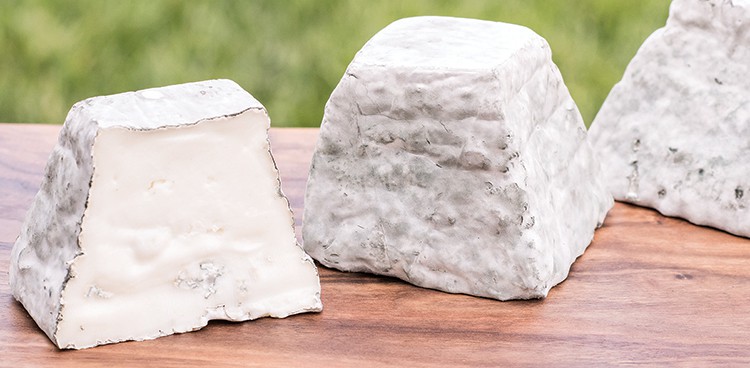
A Very Happy Accident is featured in our Summer 2017 issue.
Accident, a town of 320 people in Garrett County, occupies a rough triangle of land in the westernmost corner of Maryland. Though within striking distance of Baltimore, Pittsburgh, Philadelphia, and Washington, D.C., the hilly county is one of the most sparsely populated areas in the state. Bordered by West Virginia to the south and west and by Pennsylvania to the north, the bucolic region drew Mike Koch and his husband, Pablo Solanet, who both lived and worked in D.C. (as a financial services executive and a chef, respectively), to buy a 130-acre farm there in 1997.
They knew they wanted to start a business, and when deciding among beekeeping, growing greens and herbs, and cheesemaking, the couple chose cheese. “We’d been reading about Mary Keehn at Cypress Grove, Allison Hooper and Bob Reese at Vermont Creamery, [Judy Schad] at Capriole,” Koch says. “We’re three hours from 16 million mouths in the Mid-Atlantic foodshed. We thought there was a gap to be filled for goat cheese in the [region].”
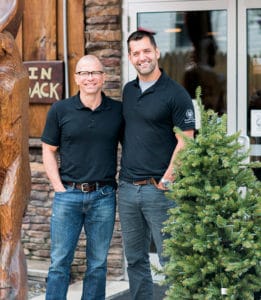
Mike Koch and Pablo Solanet, the founders of FireFly Farms
Though the couple had no prior cheesemaking experience, they dove in. The men attended a cheese technology course at the University of Wisconsin at Madison, and between Solanet’s culinary background and some chemistry courses Koch took in college, they found their way, discovering that “cheese is something you learn to make by doing it again and again and again,” Koch says. They founded FireFly Farms in 2000, and their first wheels hit markets in 2002.
The pair planned to begin with fresh chèvre, a soft-ripened pyramid, and blue cheese. The proximity of the bloomy-rind pyramid to the blue wheels in the creamery, however, created something else altogether. “The brie got into the blue and it totally changed the cheese,” Solanet says. “I thought I’d made a mistake, but [the cross-pollination] made it creamy with a really mild blue-cheese flavor.”
Koch and Solanet ran with the unintended consequences. During the summer of 2002, the cheese (christened MountainTop Bleu, a name inspired by the nearby Allegheny Plateau) won a blue ribbon at the American Cheese Society Judging & Competition. Since then, the blue-gray pyramid has racked up 27 more awards—making it FireFly’s most decorated cheese. It’s little wonder: With an understated, earthy funk from the blue cultures and a gooey texture that develops as the cheese ripens from the outside in, MountainTop Bleu is a unique but approachable crowd-pleaser.
“The first time I tried it, I didn’t realize [what it was],” says Alicia Clugh, founder of the Maryland Cheese Guild. “I always say to people, if you don’t think you like blue cheese, try it— this is like a gateway drug.”
COMMUNITY SERVICE
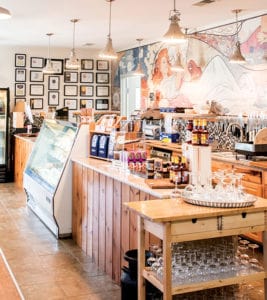
FireFly Farms’ retail shop in Accident, Md.
Today MountainTop Bleu is part of FireFly’s growing line, which also includes the cooked-curd wheel Bella Vita and an aged washed rind named Cabra La Mancha, among others. In 2017 the farm will produce 200,000 pounds of cheese, according to director of operations Matt Cedro, who has been with the company since 2003 and now runs day-to-day production. The business includes a retail outlet and a 3,000-square-foot creamery built in 2011 (the original creamery was down the road in Bittinger, Md.), and employs 25 people, 15 of whom are full-time. The company sources milk from a network of seven goat dairies just over the border in Somerset County, Penn.
FireFly Farms is dedicated to creating opportunities in this rural region, says Koch, who served as Garrett County’s director of economic development from 2012 to 2015. “It’s remarkable to see what they’ve done—where they’ve done it,” Clugh adds. In an area where farmers struggle to make a living, Koch and his team are devoted to their milk suppliers. They pay higher milk prices than the farmers would get in the commodity market and offer incentives for high quality.
“In 2016, 44 percent of the value of our cheese sales went into the pockets of our farmers,” Koch says. “We care about that—if they succeed, we succeed.”
In an economy driven heavily by tourism (nearby Deep Creek Lake draws visitors from across the region) and the seasonal, often part-time jobs that come with it, FireFly staffers enjoy health benefits, paid sick time and vacation time, and a retirement plan. Employee retention is high as a result, Cedro says. Some workers have stayed on board a decade or longer—including Cedro’s wife, Andrea, who runs sales and marketing, and director of cheesemaking Dan Porter.
Cedro started at FireFly as an apprentice and now works with new hires. “First, they become sanitarians—sanitation is number one in cheesemaking,” he says. “Slowly but surely we integrate them into the cheesemaking process.”
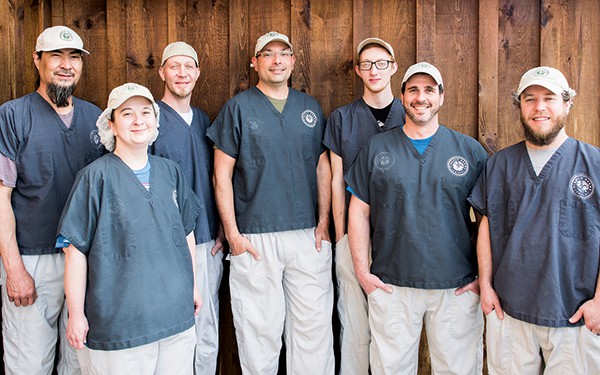
Director of operations Mike Cedro (center) stands with members of the cheesemaking team
COMPLICATED CULTURES
Currently seven FireFly cheesemakers are trained to make MountainTop Bleu. After the goat’s milk is pasteurized, cultured (with both P. candidum and P. roqueforti), and set with rennet, it rests 30 minutes before curds are cut into marble-size pieces and stirred. “The goal is to get the curd to the same consistency every time for when it goes into the molds,” Cedro says.
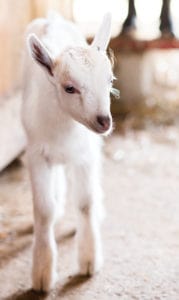
A curious kid at one of the Pennsylvania farms where FireFly sources its milk
Reaching that goal takes skill, he says, because the stirring process changes depending on the fat and protein levels in the milk and the amount of moisture in the curds. The most experienced cheesemakers, then, get the task. “It’s a ‘feel’ thing,” Cedro says, “something you learn over time.” When curds are ready, team members ladle them into pyramid molds. The cheeses drain a day before they’re unmolded and soaked in brine a few hours before heading to the aging room.
During ripening, blue mold appears on the cheese’s surface first. Staffers then have a two-day window before candidum growth emerges to pierce the pyramids, which encourages MountainTop’s delicate veining to develop in the paste. Soon after, Cedro explains, white mold grows on the rind, covering the blue mold and suppressing its growth. As the cheese matures, “you get a balance of the mild blue flavor with that gooeyness [from the] soft-ripening process,” induced by the candidum, he says.
After two weeks, the cheese is wrapped for sale and transferred to cold storage, where low temperatures curtail ripening. The team holds the cheese until it reaches just the right point—most retailers and distributors prefer to receive the cheese when it’s about 30 days old, Cedro says, so they have time to sell it at varying levels of maturity. MountainTop Bleu “reaches its peak anywhere from 60 to 90 days from the beginning of production,” he adds.
Once shipped, MountainTop Bleu makes its way to FireFly’s retail and restaurant customers. The company will sell almost $2 million worth of cheese this year, helping to stimulate the economy further—fostering full-time, career-track jobs with benefits and offering fair prices for farmers, thereby allowing them to expand their herds—in this corner of the countryside.
“They have their act together,” Clough says of FireFly Farms. With more than two decades of careful planning directed by Koch, Solanet, and team, this is clearly—wait for it—no accident.
WHERE TO BUY
DELAWARE
Janssen’s Market
3801 Kennett Pike
Wilmington, DE
302.654.9941
ILLINOIS
Standard Market
1508 Aurora Ave.
Naperville, IL
630.536.1630
333 E. Ogden Ave.
Westmont, IL
630.366.7030
MARYLAND
FireFly Farms Creamery & Market
107 S. Main St.
Accident, MD
301.746.8188
Gilbert’s Provisions
25 Commerce St.
Berlin, MD
410.973.2334
Tastings Gourmet Market
1410 Forest Dr.
Annapolis, MD
410.263.1324
MASSACHUSETTS
Boston Cheese Cellar
18 Birch St.
Roslindale, MA
617.325.2500
NEW JERSEY
Shop-Rite
808 Rte. 46
Parsippany, NJ
973.335.2625
NEW YORK
Eastern District
1053 Manhattan Ave.
Brooklyn, NY
718.349.1432
VIRGINIA
Cheesetique
2411 Mt. Vernon Ave.
Alexandria, VA
703.706.5300
The Organic Butcher of McLean
6712 Old Dominion Dr.
McLean, VA
703.790.8300
In addition to the shops above, FireFly Farms cheeses may be found throughout the Mid-Atlantic in grocery stores such as MOM’s Organic Market, Whole Foods Market, and Wegmans.
ENJOYING MOUNTAINTOP BLEU
When MountainTop Bleu is young and still firm, the cheese holds its shape when cut and may be crumbled over spinach salads sweetened with berries or softened atop a burger. When the pyramid ages, spoon its gooey paste onto crackers or baguette slices and dollop with plum or fig jam—those lush, round fruit flavors complement the understated blue flavor and creamy texture of the cheese beautifully.



